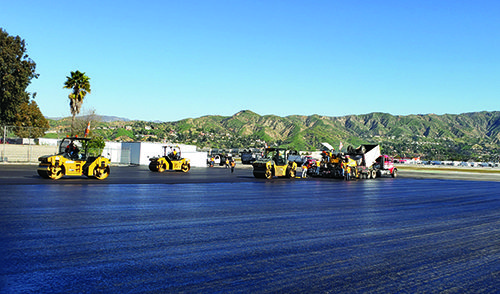Known for its ability to resist damage from spilled fuel and oil, P-404 asphalt mix has been used throughout the world for at least three decades. In the U.S., it emerged as the mix of choice for a major repaving project at LaGuardia Airport about 17 years ago, and the supplier reports that it is still holding strong with years of life remaining.
Known for its ability to resist damage from spilled fuel and oil, P-404 asphalt mix has been used throughout the world for at least three decades. In the U.S., it emerged as the mix of choice for a major repaving project at LaGuardia Airport about 17 years ago, and the supplier reports that it is still holding strong with years of life remaining.
The polymer-modified material was also selected for the recent $5 million ramp rehabilitation at Hollywood Burbank Airport (BUR) in California. However, since this was the first time P-404 was installed on the West Coast, the project team encountered some challenges. Mix design/production and various installation issues proved to be new frontiers.
With the project complete, however, BUR is looking forward to high performance throughout the material’s lifecycle. The new pavement is located on a general aviation ramp regularly used by prominent media conglomerates.
|
Project: Ramp Rehabilitation Location: Hollywood Burbank Airport (CA) Owner: Burbank-Glendale-Pasadena Airport Authority Project Budget: $5 million Schedule: Sept. 2018 – March 2019 Installation Site: General aviation ramp Asphalt Specified: P-404 Product Cost: $170/ton Amount Applied: About 4,500 tons Engineer: RDM Int’l Inc. General Contractor: Sully-Miller Contracting Co. Asphalt Supplier: HollyFrontier Asphalt Co. P-404 Binder & Mix Concept: Associated Asphalt Partners LLC Key Benefits: Fuel & oil doesn’t penetrate into the pavement; increased resistance to ruts & cracks |
“We have quite a few tenants in this area,” says Karen Sepulveda, manager of Construction Services for BUR. “Although tenants house their aircraft within the hangar space, there are occasions when some park on the ramp. We decided to have this fuel-resistant mix uniformly placed in front of all the hangars. Certain tenants may need to place metal plates on the pavement if they have very heavy aircraft, since the material is highly resistant, but not impervious.”
Product Breakdown
The FAA P-404 specification (renumbered from P-601 in December 2018) is a highly polymer-modified asphalt mix that helps prevent damage from jet fuel and hydraulic oil that spill onto airfield pavement. It also does not require sealers to maintain fuel resistance later in the life of the pavement—a primary attraction for BUR. Moreover, the polymers in the liquid asphalt make the pavement extremely resistant to rutting and cracking.
The product uses the P-401 mix gradation, but the mix design criteria is modified to include more asphalt. The resulting P-404 mix is designed to include 2.5% air voids (compared to 3.5% for P-401 mixes) and is compacted with 50 Marshall blows or 50 gyrations (compared to 75 blows or 75 gyrations for P-401). These changes typically increase the liquid asphalt content in the P-404 mix to 7% (compared to a typical 5.5% asphalt content for a P-401 mix).
Lower air voids in the P-404 mix make it impermeable to jet fuel and hydraulic oil spills. Instead of seeping into the pavement, the damaging liquids sit on the surface and either evaporate or get cleaned up. Higher asphalt content in the mix, combined with the polymers in the liquid asphalt, make it more durable.
 Associated Asphalt Partners LLC developed the P-404 binder and mix concept for use in the U.S. Ron Corun, the company’s sales and marketing manager for specialty products, explains that enhanced resistance to fuel, rutting and cracking makes P-404 an ideal pavement for aprons and taxiways where planes are parked or moving very slowly. The structural strength and fuel/oil resistance both appealed to BUR for its recent project.
Associated Asphalt Partners LLC developed the P-404 binder and mix concept for use in the U.S. Ron Corun, the company’s sales and marketing manager for specialty products, explains that enhanced resistance to fuel, rutting and cracking makes P-404 an ideal pavement for aprons and taxiways where planes are parked or moving very slowly. The structural strength and fuel/oil resistance both appealed to BUR for its recent project.
The special properties of the mix allowed engineers to reduce the wearing course layer thickness to a 1-inch minimum depth. The associated savings helped offset the increased cost of the P-404 mix.
Learning Curve
While P-404 had the right properties to address fuel stains and ramp sealing, BUR also chose it to help tackle other previous issues in its hangar areas. But to deliver those benefits, the project’s general contractor had to design and produce an unfamiliar asphalt mix and bridge the associated knowledge gap.
Mix design was the most difficult aspect for Mike Ramos, quality control manager at Sully-Miller Contracting Company. Not only was P-404 new to his company, no other contractor in California had made it, either.
Sully-Miller initially relied on expertise from Associated Asphalt regarding the gradation/binder concept, and then conducted multiple trials at its own test lab to learn about and verify the mix properties. After the mix was verified at the Sully-Miller plant, Ramos and his team made sure it was workable within the scope of the job.

Yet another challenge: The fuel-resistant binding agent, PG 88-22FR, was not available in California; so Sully-Miller had to procure it out of state. HollyFrontier Asphalt Company, a regional partner of Associated Asphalt, supplied the binder from its facility in Phoenix. The company routinely sells liquid asphalt products in California, but this was the first time it produced and sold the PG 88-22FR binder.
To verify that the binder was properly formulated with the fuel-resistant additive, samples of the proposed aggregate and binder were sent to Rutgers University for testing. Once the proper binder formulation was developed, the binder was produced at the refinery in Phoenix and shipped to Sully-Miller’s hot mix asphalt plant in California for further mix design development.
The production process included a few hiccups due to the special logistics of trucking in the binder from Phoenix. Initially, the product took hours to pump off the truck, because it was too cold. After Sully-Miller communicated with the refinery, it produced and shipped the binder at a higher temperature to help reduce the off-loading time. Coordination between plant personnel and the project team proved critical throughout production.
“We had to go through several plant trials to get the mix dialed in, and sought some advice from the manufacturers of the binder and additive to get that done,” Ramos recalls. “Eventually, we got the mix design together, verified the mix at the plant and in the field, got approval from the airport and went forward with placement.”
Give an Inch…
 The airport selected RDM International Inc., a consulting firm that specializes in pavement design, as the project engineer. It specified a 1-inch thick P-404 overlay for the wearing course of the apron based on FAA’s recommended range of 1-inch minimum and 2-inch maximum for the material. Project Manager Chris Decker explains that specifying a 1-inch thickness helped address budget considerations yet still provided a durable product for long-term performance. The savings added up quickly, because the technologically advanced material cost $170 a ton for about 4,500 tons.
The airport selected RDM International Inc., a consulting firm that specializes in pavement design, as the project engineer. It specified a 1-inch thick P-404 overlay for the wearing course of the apron based on FAA’s recommended range of 1-inch minimum and 2-inch maximum for the material. Project Manager Chris Decker explains that specifying a 1-inch thickness helped address budget considerations yet still provided a durable product for long-term performance. The savings added up quickly, because the technologically advanced material cost $170 a ton for about 4,500 tons.
However, the thinner overlay created some problems during installation. BUR Construction Manager Mike Perry explains that the P-404 cooled too quickly, especially at 1-inch thickness. The project was consequently phased into small areas to address daily operations, and it required hot longitudinal joints between paving lanes. When the material temperature dipped below 160 degrees Fahrenheit during inclement weather in January, crews had to cut the longitudinal paving lane joint and pave up against a new edge. As a result, the pulls were not very long. While the pavement is functional, the joints are not as aesthetically pleasing as it would have been with a thicker layer, explains Perry.
 “We have experienced a lot of problems with cold joints, so we try to avoid them if possible,” adds Sepulveda. “The material looks like silk with a nice looking mat without them. The hot joints are much less noticeable. So in this case, you do see all the cold joints.”
“We have experienced a lot of problems with cold joints, so we try to avoid them if possible,” adds Sepulveda. “The material looks like silk with a nice looking mat without them. The hot joints are much less noticeable. So in this case, you do see all the cold joints.”
Corun, from Associated Asphalt, notes that the P-404 specification includes a stringent density requirement for a maximum of 4% in-place air voids. “A 1-inch pavement thickness and cool weather conditions made this a challenge, but the Sully-Miller paving crew quickly developed a roller pattern that allowed them to meet the specification,” he comments.
In retrospect, Decker says a 1½-inch layer thickness would have given the contractor more leeway when placing the material. In fact, FAA Advisory Circular 150-5370-10H—which was issued in December 2018 after the BUR design was complete—raised the minimum thickness for future P-404 pavement to 1½ inches.
Spec changes notwithstanding, Decker believes BUR’s new pavement will serve the airport well for many years to come. And Corun predicts it will outperform and outlast any P-401 pavement alternative.


 facts&figures
facts&figures

